can a lightsaber be made
![]()
- "An elegant weapon for a more civilized age."
- ―Obi-Wan Kenobi giving Luke Skywalker his father's lightsaber [src]
The lightsaber, also referred to as a laser sword by those who were unfamiliar with it, was a weapon usually used by the Jedi, the Sith, and other Force-sensitives. Lightsabers consisted of a plasma blade, powered by a kyber crystal, that was emitted from a usually metal hilt and could be shut off at will. It was a weapon that required skill and training, and was greatly enhanced when used in conjunction with the Force. Though also used by the Sith, the lightsaber was synonymous with the Jedi, with some in the galaxy believing only Jedi could use lightsabers.
Lightsabers were generally used for both offense and defense. A lightsaber could cut through virtually anything, from flesh to blast doors. The only ways to block the incoming attack of a lightsaber was with a weapon made with material that conducted energy, such as an electrostaff, a Z6 riot control baton, some rare metals, or another lightsaber. When used defensively, a Force-sensitive could deflect blaster bolts with a lightsaber, and with skill, could even reflect the shots back toward the shooter or some other target. Experienced Jedi could even employ their lightsabers to absorb Force lightning. Most practitioners used one single-bladed lightsaber, though some used double-bladed lightsabers or even multiple lightsabers at once.
Lightsaber combat was divided into seven Forms: Form I, Form II, Form III, Form IV, Form V, Form VI, and Form VII.
Contents
- 1 History
- 2 Mechanics and specifications
- 2.1 Components
- 2.2 Aesthetics
- 2.3 Cutting power
- 2.4 Lightsaber-resistant materials
- 2.5 Utility
- 3 Variations
- 4 Usage and application
- 4.1 Purpose
- 4.2 Combat
- 4.3 Rituals
- 4.4 Practical applications
- 5 Behind the scenes
- 5.1 Early concepts
- 5.2 Prop design and effects
- 5.3 Colors
- 5.4 Choreography
- 5.5 Trivia
- 5.6 Star Wars: Visions
- 6 Appearances
- 6.1 Non-canon appearances
- 7 Sources
- 8 Notes and references
- 9 External links
History [ ]
- "I don't get to treat many lightsaber wounds. It's such an old weapon. People today prefer to fight with rifles and blasters, from long range."
- ―Harter Kalonia, to Rey [src]
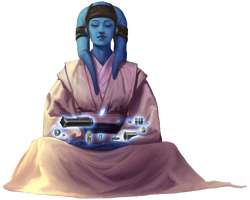
A Twi'lek Jedi using the Force to assemble her lightsaber.
Sounding like no other weapon in the galaxy,[13] lightsabers were used thousands of years before the age of the Galactic Republic, seeing use in the Great Scourge of Malachor.[14] They were also used in the Battles of Rashfond and the Peacekeeping of Parliock,[1] The proto-saber was an ancient type of prototype lightsaber.[15]
Lightsabers took on a more prominent role in galactic affairs as the Clone Wars came to pass. Jedi, previously peacekeepers, became Jedi Generals of the Grand Army of the Republic, and thus began using their lightsabers more often than they had in their role of peacekeeping.[16]
For the majority of the reign of the Empire, the only lightsaber that was prominently used was that of Darth Vader, and, in its waning years, that of the exiled Obi-Wan Kenobi and Luke Skywalker.[2]
After the Empire was defeated, Luke began training a new generation of Jedi. These, however, were killed during the destruction of his Jedi, once again leading to a time where the only prominent lightsaber user was a darksider, Kylo Ren.[12]
That all changed when a scavenger, Rey, discovered the Skywalker lightsaber[12] and ultimately came to train with Luke Skywalker and his twin sister, Leia Organa to combat Kylo Ren and the First Order during a war against the Imperial Remains.[17]
After the war, Rey ritually buried her masters' lightsabers at the Lars Homestead of their home planet, Tatooine to end the Skywalker's suffering, she ignited her newly crafted lightsaber to show her complete journey as a Jedi, and to honor their legacy, she took the Skywalker name as her surname after receiving this blessing from the force ghost of her teachers when she was asked by a local.[18]
Mechanics and specifications [ ]
Components [ ]
- "From the Battles of Rashfond, to the Peacekeeping of Parliock, to our very own Clone Wars, the lightsaber is a Jedi's only true ally. But how do they work? Hmm? Yes, you have brought me crystals, but they're all useless unless you give them life."
- ―Huyang, to a class of Jedi younglings [src]
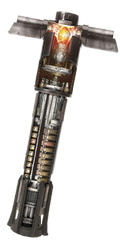
The inner workings of Kylo Ren's lightsaber.
A lightsaber drew power from an appropriately-sized power cell.[19] Parts that would work to make a lightsaber include modulation circuits and an energy gate. Ones that were necessary include a blade emitter shroud, the emitter matrix and some type of activator to turn the weapon on and off. Other parts that could be added include handgrip ridges and a blade length adjuster.[19] [10] Some lightsabers also featured a non-lethal low-power setting used for training.[20] Single-bladed lightsabers usually had a belt ring so they could be hung from a belt hook, or a wheel-shaped attachment that slotted into a matching belt clip on the owner's belt when not in use.[21] [22] [23] [24] [19]
Specially designed lightsabers could even use unstable crystals, such as Kylo Ren's lightsaber, which featured two laterally facing vents designed to divert excess energy away from the cracked crystal and keep the lightsaber stable.[25]
During assembly, it was important to not accidentally invert the emitter matrix; when activated the lightsaber's power grid would backfire. At best this could cause the blade to quickly short out, but if it was left on, the faulty weapon would violently explode, potentially killing those in close proximity.[1]
Aesthetics [ ]
- "It's a metal cylinder, about this long, with black grips and a few switches on the side."
- ―Luke Skywalker describes a lightsaber [src]
Hilts were made up of multiple parts that enveloped and protected the internal components. Metal ranging from simple alloys to Haysian smelt[26] was usually chosen to make up the hilt, but a casing carved from the Brylark tree, wood that was strong as metal, would also work.[1] Some hilts were even crafted with gems.[27] Inlays decorating the hilt could be made of materials such as pastillion ore, black onk, or bone from certain creatures such as the Cartusion whale.[1] Each piece of the hilt was aesthetically tailored towards one of multiple different design philosophies, which both informed and were informed by the maker's choice of materials, ideology, and personal preferences.[26] [28] [29]
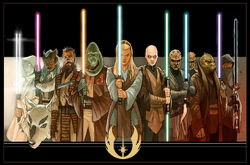
Various types of lightsabers were in use during the High Republic Era.
The Jedi Order of the late Galactic Republic made use of four styles: Duty and Resolve, Peace and Justice, Elemental Nature, and Valor and Wisdom.[26] [28] The former two were simple designs intended to reflect the Jedi commitment to a life of devotion to the Force and the Order's ideals.[30] [31] The latter two made use of resilient natural materials derived from flora and fauna to evoke the living Force.[30] [31]
The Sith Order made use of two styles: Passion and Strength, and Power and Control.[26] [28] Both were characterized by sharp and strong forms that showcased their owners' brutality, relentlessness, and insatiable desire for supremacy.[30] [31]
Another style, Protection and Defense, was favored by the earliest Force users in ancient times. It featured designs and inscriptions with meanings that have become shrouded in mystery, but the style itself was believed to have been created with the intent of conferring anonymity upon and symbolizing the emotional detachment of the wielder, who would use their lightsaber strictly for personal protection.[28] [31]
Cutting power [ ]
- "It's heavier than I thought."
"Energy constantly flows through the crystal. You're not fighting with a simple blade as much as you are directing a current of power." - ―Sabine Wren and Kanan Jarrus on the Darksaber [src]
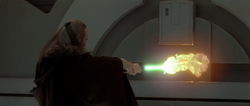
Qui-Gon Jinn using his lightsaber to cut through one of the Saak'ak's blast doors.
The power of the energy blade was so great that it could cut through almost anything. One important note about lightsaber wounds was that they rarely bled profusely, even when a limb had been severed.[32] [21] [22] This was because the energy blade cauterized the wound as it passed, and thus even a severe wound did not tend to bleed heavily.[23]
Lightsaber-resistant materials [ ]
Aside from the blade of another lightsaber, there were rare materials that could withstand a lightsaber blade:
- Zillo Beast hide could deflect lightsaber strikes, but this material was exceedingly rare due to the species' extinction.
- Beskar was specially crafted steel made from an iron found only on the planet Mandalore and its moon Concordia, and could repel lightsaber strikes.[33] Din Djarin's armor, which resisted Ahsoka Tano's lightsaber blades, or the beskar staff offered to Din Djarin by Morgan Elsbeth, the magistrate of Calodan, which was also used to fight against Tano's sabers.[34]
- The armor of the Elite Praetorian Guard was able to resist lightsaber strikes, with the gauntlets being capable of parrying one directly. However, a direct thrust or stab could still penetrate the armor.[17]
- Cortosis armor, made by specially weaving cortosis fibers within a protective matrix, was able to redirect a lightsaber's energy into itself which would cause the lightsaber's blade to temporarily shut off upon contact with the armor.[35]
- A personal energy shield powered by extremely rare kohlen crystals was impervious to kyber crystal lightsabers. However, swapping out a lightsaber's kyber crystal for a kohlen crystal would produce a low-powered orange blade which was capable of slicing through the shields.[36]
- The rare metal Phrik is impervious to lightsaber blades. A staff made of this material was once on display during the Valo Republic Fair, which was taken and used by the Nihil Tempest Runner Lourna Dee to fend off the Jedi Archivist OrbaLin. [37]
Utility [ ]
On the aquatic planet of Mon Cala, the Jedi Kit Fisto, Anakin Skywalker and Ahsoka Tano were all able to use their lightsabers underwater with no ill effects.[38] Whilst in areas of low light, the glowing plasma blade could function as a convenient light source, demonstrated by Jedi Knight Anakin Skywalker,[39] Jedi Masters Yoda[source?] and Obi-Wan Kenobi,[39] along with Savage Opress.[40]
Variations [ ]
- Sith lightsaber—The lightsabers wielded by members of the Sith. The designs of Sith lightsabers depended on the user.[5]
- Double-bladed lightsaber—Double-bladed lightsabers consisted of a hilt that projected a blade from both ends, resulting in a deadly staff-like weapon.[21]
- Hinged double-bladed lightsaber—Was a type of double-bladed lightsaber that could fold in half, making it easier to store while not in use.[41]
- Double-bladed spinning lightsaber—A double-bladed spinning lightsaber projected a blade from each end of the hilt. However, the hilt was as long as a single-bladed lightsaber, with a circular rim that, when activated, could spin the blades along a track.[42]
- Split saber—A split saber consisted of two separate lightsabers that join together forming a double-bladed lightsaber.[43]
- Lightsaber pike—Featuring two yellow plasma blades on each side of the staff, lightsaber pikes were used by the Jedi Temple Guard.[44]
- Dual-phase lightsaber—A dual-phase lightsaber contained one or multiple focusing crystals, which allowed its blade length to be extended or shortened in the middle of combat.[5]
- Broadsaber—A lightsaber with a broad flat blade that resembled a traditional sword.[45]
- Great lightsaber—A great lightsaber was a lightsaber made for individuals with a giant stature.[45]
- Crossguard lightsaber—An ancient design dating back to the Great Scourge of Malachor, a crossguard lightsaber consisted of a standard blade with two shorter blades perpendicular to it at the end of the hilt.[25]
- Curved-hilt lightsaber—Curved-hilt lightsabers were of a design which featured a hilt with a built in curve. This was usually done to allow the hilt to fit better into the palm, facilitating the use of one-handed fighting styles such as Form II.[46]
- Cane lightsaber —A standard lightsaber concealed as the head of a cane. In combat, the handle would be detached from the body of the cane and wielded normally.[46]
- Training lightsaber—Training lightsabers were engineered with a permanent low-power setting. As their name indicates, training lightsabers were used for instructional purposes, teaching initiates how to wield a lightsaber.[47]
- Shoto lightsaber—A shoto was a short lightsaber. Featuring a shortened blade length, shotos were usually used as the secondary weapon in dual-blade combat.[5]
- Guard shoto—A guard shoto was a lightsaber with a hilt perpendicular to the blade that gave a unique way of blocking and attacking.[5]
- Lightwhip—A lightwhip had a flexible blade that was several meters long, and could entangle opponents.[48]
- Lightsaber-blaster hybrid—A single bladed lightsaber with an attachment that allowed it to fire blaster bolts.[19]
- Darksaber—An unique ancient lightsaber with a black blade that was flattened and came to a point like a traditional sword, rather than the rounded beam of standard lightsabers.[49]
There also existed a type of blaster known as a lightsaber rifle which was designed to be combined with lightsaber. To work, the user would insert a standard lightsaber into a slot on top of the rifle. Once loaded, the weapon could fire powerful beams of energy that were highly destructive.[50]
Usage and application [ ]
Purpose [ ]

The Jedi used their lightsabers to bring an end to conflicts.
The intended purpose of the lightsaber was that it was to be used to bring an end to conflicts, being designed so that they could injure no more than its wielder chose. Additionally, there was no collateral damage from lightsaber strikes[13] unless the blade happened to hit a target on accident.[51] If death was deemed necessary, the blade was designed to kill quickly. Even though the Jedi held themselves to these rules,[13] the groups like the Sith chose to use their lightsabers in ways that could cause suffering.[52]
Jedi Padawan Bell Zettifar also felt that the lightsaber was designed so as to give an enemy a chance to surrender, as it was easy to spot and hear. Furthermore, he believed the blade's sound was one of training, focus, and skill; it was the sound of a Jedi's last resort and was the art of their Order.[13]
Combat [ ]
- "Energy constantly flows through the crystal. You're not fighting with a simple blade as much as you are directing a current of power. Your thoughts, your actions, they become energy. They flow through the crystal as well and become a part of the blade."
- ―Kanan Jarrus, to Sabine Wren [src]

Anakin Skywalker and Darth Tyranus engaged in lightsaber combat above Coruscant.
Lightsaber combat was the preferred fighting method used by lightsaber wielders. Throughout the millennia, many combat styles were refined into the seven "classic" forms that serve as the standard,[46] and numerous other fighting methods that call for advanced levels of skill. Lightsabers were most often held with both hands during combat.[22]
Rituals [ ]
- "By the right of the Council, by the will of the Force, Kanan Jarrus, you may rise."
- ―An apparition of The Grand Inquisitor as a Jedi knights Kanan Jarrus [src]
Lightsabers were an integral part of the knighting ceremonies of the Jedi Order. During the ceremony, a Padawan would have his or her Padawan braid ritualistically severed by the presiding Jedi Master.[source?]
Practical applications [ ]
Lightsabers were able to cut through most materials.[source?] The glowing plasma blade could be used as a convenient light source when necessary.[18] [26]
Behind the scenes [ ]
Early concepts [ ]
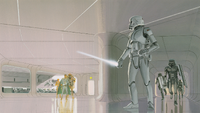
Early concept art of lightsabers.
The usage of the lightsaber was originally inspired by many of the serials that George Lucas watched and enjoyed as a child, which featured many characters wielding swords. When he began conceiving Star Wars, he wished to include swords, creating the "lightsaber" to allow them to better mesh with the futuristic setting.[53]
In the early incarnations of the Star Wars storyline, lightsabers were not exclusive to the Jedi and other Force-users, but were in fact very mundane. Early concept art depicts lightsabers being wielded by Rebel and Imperial soldiers alike. George Lucas later limited the lightsabers to exclusively the Jedi in order to make them feel more unusual, and heighten the mystique of the Jedi.[54] Also, in early drafts of the script, lightsabers were referred to as "lazerswords."[source?]
Crystals first appear in Star Wars simply as an embedded decoration on the hilt in the original film's novelization. Aside from this single instance, there are no crystals mentioned in any of the movies or their novelizations.[55]
Prop design and effects [ ]
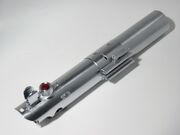
A Graflex flash similar to the one used for Luke Skywalker's first lightsaber.
During the filming of A New Hope, the Anakin/Luke lightsaber was made from a Graflex camera side-attach flash, while Darth Vader's lightsaber was made from a Micro Precision Products flash attachment. The handle grips were made with T-shaped pieces of plastic from sliding glass cabinet windows and, contrary to popular belief, were not made with rubber windshield wipers. D-rings were attached to the bottoms of the units so that they could be worn on belts. Obi-Wan Kenobi's lightsaber was the most complex hilt at the time. It was assembled from parts of an Armitage Shanks Starlite model Handwheel, Browning ANM2 machine gun booster, WWI No.3 Mk.1 British Rifle Grenade and a Rolls-Royce Derwent Mk.8/Mk.9 Jet Engine Balance Pipe.[source?]
Korean animator Nelson Shin, who was working for DePatie–Freleng Enterprises at the time, was asked by his manager if he could animate the lightsaber in the live action scenes of a film. After Shin accepted the assignment, the live action footage was given to him. He drew the lightsabers with a rotoscope, an animation which was superimposed onto the footage of the physical lightsaber blade prop. Shin explained to the people from Lucasfilm that since a lightsaber is made of light, the sword should look "a little shaky" like a fluorescent tube. He suggested inserting one frame that was much lighter than the others while printing the film on an optical printer, making the light seem to vibrate. Shin also recommended adding a degausser sound on top of the other sounds for the weapon since the sound would be reminiscent of a magnetic field. The whole process took one week, surprising his company. Lucasfilm showed Shin the finished product, having followed his suggestions to use an X-Acto knife to give the lightsaber a very sharp look, and to have sound accompany the weapon's movements.[56]
The lightsaber effects during the original trilogy started out in a very complicated manner. During the filming of A New Hope, the blade was made of a three-sided rod covered with reflective material. The rod was then rapidly spun by a compact motor in the hilt, reflecting the lights on set and creating an in-camera glowing effect. However, these props were highly limited; they were cumbersome and fragile, often breaking during fight scenes. Also, the glowing effect was not absolute, as whenever the blade moved out of the light or pointed more directly at the camera the glow disappeared and the actual spinning rod could be seen. In order to partially compensate for this loss of the effect, the blade was rotoscoped and an animated glow was added by tracing onto a blown-up copy of the frame with pen and colored ink, one frame at a time. It was at this phase that blades were given colors, as the props were simple white rods.[53] [54]
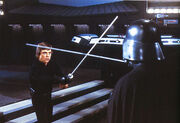
Mark Hamill and Bob Anderson duel with carbon rods.
During the filming of The Empire Strikes Back, it was decided creating an in-camera glowing effect was more trouble than it was worth, so the spinning rods were swapped for carbon rods. While these new blades were less cumbersome than before, they were still very fragile and frequently broke. However, they continued to be used for Return of the Jedi.[53]
When filming began for The Phantom Menace, the new lightsaber blades were steel and aluminum rods, which were highly durable, but frequently bent and flexed, requiring constant replacement.[57] Despite such a drawback, these rods still saw usage during the filming of Attack of the Clones, as they had no alternative at the time. However, for the filming of Revenge of the Sith, the blades were replaced by carbon fiber rods laminated with glass and plastic. These new props were highly durable and didn't flex, though they were extremely hard, often causing bruising and leaving scars. While lightsaber effects were still done by rotoscoping for the prequels, they were done digitally, rather than by hand.[54]
For The Force Awakens, the lightsaber props glowed, using a similar effect used in Attack of the Clones during the fight between Anakin Skywalker and Count Dooku. In behind the scenes footage, it was revealed that the actors were using blades similar to the ones made by Master Replicas. This not only added to the environmental realism that was desired by providing interactive lighting on the actors and the set, but also immersed the actors in the lightsaber experience, building on the performance and convincing nature of the lightsaber effect.[58]
Colors [ ]
Lightsabers depicted in the first two released films, A New Hope and The Empire Strikes Back, had blades that were colored either blue (for the Jedi) or red (for the Sith). This color difference was a decision during post-production when the lightsaber blades were being rotoscoped, as the original blades were simply white. In Return of the Jedi, Luke's newly-constructed lightsaber was colored blue during the initial editing of the film, and appears so in both an early movie trailer and the official theatrical posters, but in the final film, it was ultimately colored green in order to better stand out against the blue sky of Tatooine in outdoor scenes and to make it more obvious to the audience that the new lightsaber was different from Luke's one in The Empire Strikes Back. It also appeared as green in re-release posters.[source?]
Both green and blue became standard blade colors for Jedi lightsabers in the Star Wars prequel trilogy. In the same regard, red became the standard Sith lightsaber blade. Mace Windu's purple lightsaber, as first seen in Attack of the Clones, was a personal request from actor Samuel L. Jackson as a way to make his character stand out among other Jedi. Jackson's favorite color is purple and he frequently requests the characters he plays to use an item of the color in his movies. In addition, there are yellow[59] [27] [60], yellow-green[61] light-blue[61], black[62] and white[63] blades, as seen in The Clone Wars and Rebels animated series. The yellow lightsaber blade made its live-action debut in the final scene of The Rise of Skywalker, as the new weapon constructed by Rey Skywalker. Orange blades appear in the video game Star Wars Jedi: Fallen Order, as did indigo, cyan, and magenta blades.[64]
A lightsaber with a kohlen crystal inside also produced an orange blade, but with an intensity that made it mostly useless against anything other than a specialized type of shield which was also powered by a kohlen crystal.[36]
Choreography [ ]
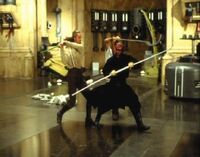
Ray Park practices dueling with the stunt doubles of Liam Neeson and Ewan McGregor.
While the usage of lightsabers was originally inspired by rapiers featured in the old serials George Lucas enjoyed, the final choreography in A New Hope looked nothing like fencing. As Jedi and their Sith counterparts were heavily inspired by samurai, the fighting styles utilized were based more on kendo.[65] The slower, more strength-oriented moves of kendo used in the Obi-Wan/Vader duel also helped mesh with Lucas' concept that it was a battle between what were essentially two old men.[53]
During the filming of The Empire Strikes Back, Lucas began ramping up the speed of the duels, making them "faster and more intense," the idea being that Luke Skywalker was becoming increasingly proficient with the weapon.[53] Also, rather than utilize David Prowse, the actor within the Darth Vader costume, for the duels, they instead had professional swordsman Bob Anderson perform the fights, due to Prowse's tendency to repeatedly break the fragile prop blades. Anderson continued to serve as Prowse's fighting double during the filming of Return of the Jedi.
When filming began for The Phantom Menace, the new stunt coordinator Nick Gillard ramped up the speed and agility the characters demonstrated in lightsaber duels, the idea being that the prequels took place when the Jedi Order was in "full flower," at least in terms of combat techniques.[53] Gillard was careful to avoid giving the fight scenes a choreographed look, drawing upon his extensive knowledge of martial arts to create the moves.[66] The end result was a very fast-paced style of fighting, which he described as being like a chess game between grand masters, with every move being a check. This style of choreography was continued on throughout the prequel trilogy.[66]
Trivia [ ]
The lightsabers were created as a reference to the sword of Flash Gordon when he beat Ming the Merciless.[source?]
Star Wars: Visions [ ]
In the alternate history of "The Duel" and Ronin: A Visions Novel,[67] Kouru wielded a lightsaber parasol—a lightsaber that used a lightsaber auxiliary to produce multiple blades that sprung up from its sides like a parasol, which could also be used without the parasol auxiliary as a single-bladed lightsaber.[68]
Appearances [ ]
Non-canon appearances [ ]
Sources [ ]
Notes and references [ ]
External links [ ]
-
 Lightsaber on Wikipedia
Lightsaber on Wikipedia
| Lightsabers | ||||||||||||||||||||
|---|---|---|---|---|---|---|---|---|---|---|---|---|---|---|---|---|---|---|---|---|
| ||||||||||||||||||||
| [edit] | ||||||||||||||||||||
can a lightsaber be made
Source: https://starwars.fandom.com/wiki/Lightsaber
Posted by: davingoetted84.blogspot.com

0 Response to "can a lightsaber be made"
Post a Comment